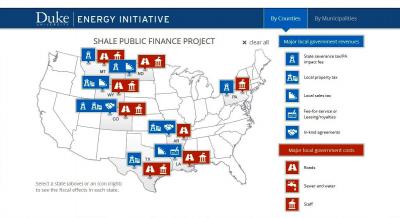Shale development generally helps local government coffers

A still image from an interactive map built by the research team which enables viewers to explore the study's findings about shale gas revenue and demand for public services around the country. The interactive map can be found here: http://energy.duke.edu/shalepublicfinance. Credit: Duke University Energy Initiative
Oil and gas development from shale fields has generally helped the public finances of local communities, providing new revenues and resources that usually — but not always — outweigh the increased demand for public services and other costs, according to a new analysis from two Duke University researchers.
Daniel Raimi and Richard Newell gathered data from communities surrounding 10 oil and gas “plays” from September 2013 through February 2014, traveling to Arkansas, Colorado, Louisiana, Montana, North Dakota, Pennsylvania, Texas and Wyoming to interview local officials and collect information firsthand.
The report, which appears online, describes major revenue sources for local governments, which can include property taxes, sales taxes and state-collected severance taxes or fees that are sent back to the local level. Some local governments also partner with oil and gas companies to help maintain roads, an approach that helped reduce expenses associated with heavy truck traffic in states including Arkansas, Colorado and Pennsylvania.
New costs for local governments associated with oil and gas development, include damage to roads from heavy truck traffic, water and sewer service expansion, government staffing and other needs brought on by rapid population growth.
The researchers found that the net impact of recent oil and gas development has generally been positive for local public finances. However, many local governments in western North Dakota and eastern Montana, near the Bakken shale formation, have thus far experienced net negative fiscal effects. Also, some municipalities in rural parts of Colorado and Wyoming struggled to manage rapid population growth as natural gas production accelerated in the mid-to-late 2000s.
“The fiscal effects for local governments tend to vary from state to state, but we found that for most of them new revenues were outweighing new demand for services,” said Newell, director of the Duke University Energy Initiative and Gendell Professor of Energy and Environmental Economics at Duke's Nicholas School of the Environment.
The research is a snapshot of the fiscal impact to date in the eight states and does not examine the long-term economic impact to governments and the communities they serve, a question the authors say is important and needs additional study.
Newell and Raimi found net positive fiscal effects in regions where oil and gas booms were ongoing or had slowed in recent years, as well as in regions that experienced different scales of activity. This includes local governments in diverse regions where population density and government capacity vary substantially.
“One of the key questions is how these fiscal effects change over time,” said Raimi, an associate in research with Duke's Energy Initiative. “In very rural areas, some local governments have faced challenges when development first surges. In many cases, those challenges faded over time. In most other areas, we found net positive or at least roughly neutral financial effects on local government.”
“In some parts of North Dakota, populations have doubled, tripled or even quadrupled just in the past few years,” Raimi said. “For local governments in these areas, it's hard to keep up with the demand for services, especially costly infrastructure projects such as sewer and water treatment plants.”
The report is the first of a series of publications to be produced by the Shale Public Finance Project, an effort led by Newell with support from the Alfred P. Sloan Foundation. The project's website provides additional information, including interactive maps and a blog about sites visited during the research.
Media Contact
More Information:
http://www.duke.eduAll latest news from the category: Business and Finance
This area provides up-to-date and interesting developments from the world of business, economics and finance.
A wealth of information is available on topics ranging from stock markets, consumer climate, labor market policies, bond markets, foreign trade and interest rate trends to stock exchange news and economic forecasts.
Newest articles

Bringing bio-inspired robots to life
Nebraska researcher Eric Markvicka gets NSF CAREER Award to pursue manufacture of novel materials for soft robotics and stretchable electronics. Engineers are increasingly eager to develop robots that mimic the…

Bella moths use poison to attract mates
Scientists are closer to finding out how. Pyrrolizidine alkaloids are as bitter and toxic as they are hard to pronounce. They’re produced by several different types of plants and are…

AI tool creates ‘synthetic’ images of cells
…for enhanced microscopy analysis. Observing individual cells through microscopes can reveal a range of important cell biological phenomena that frequently play a role in human diseases, but the process of…





















